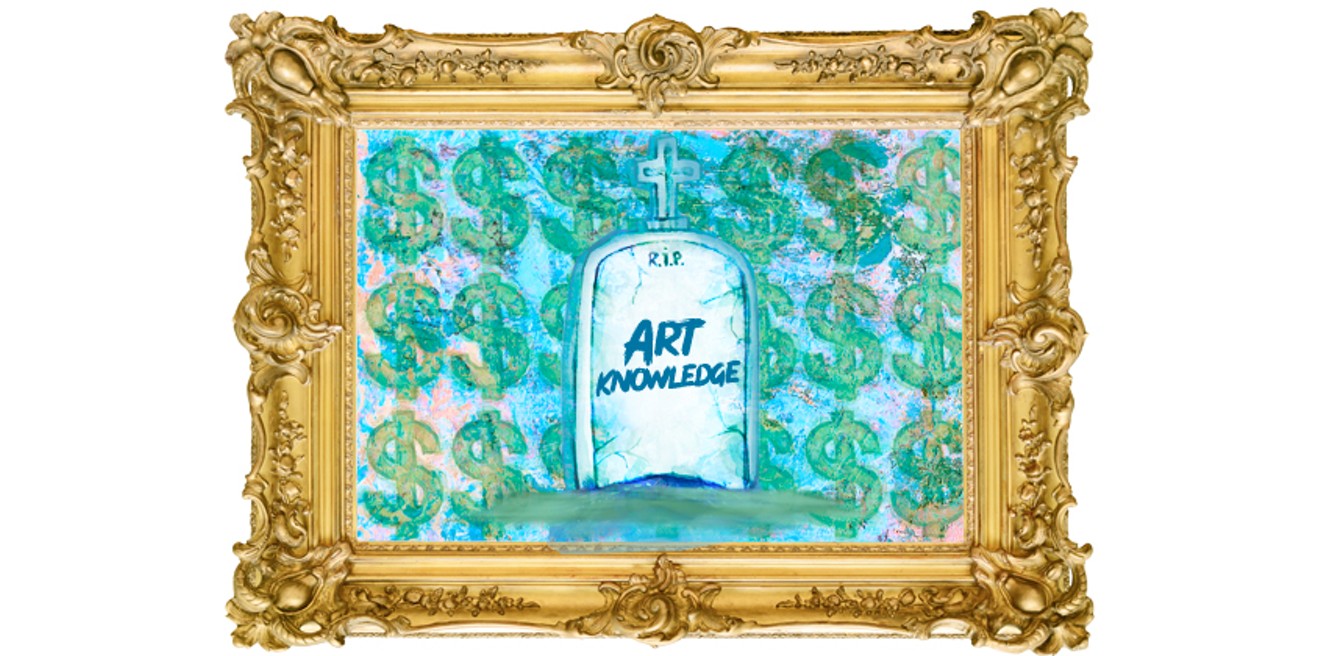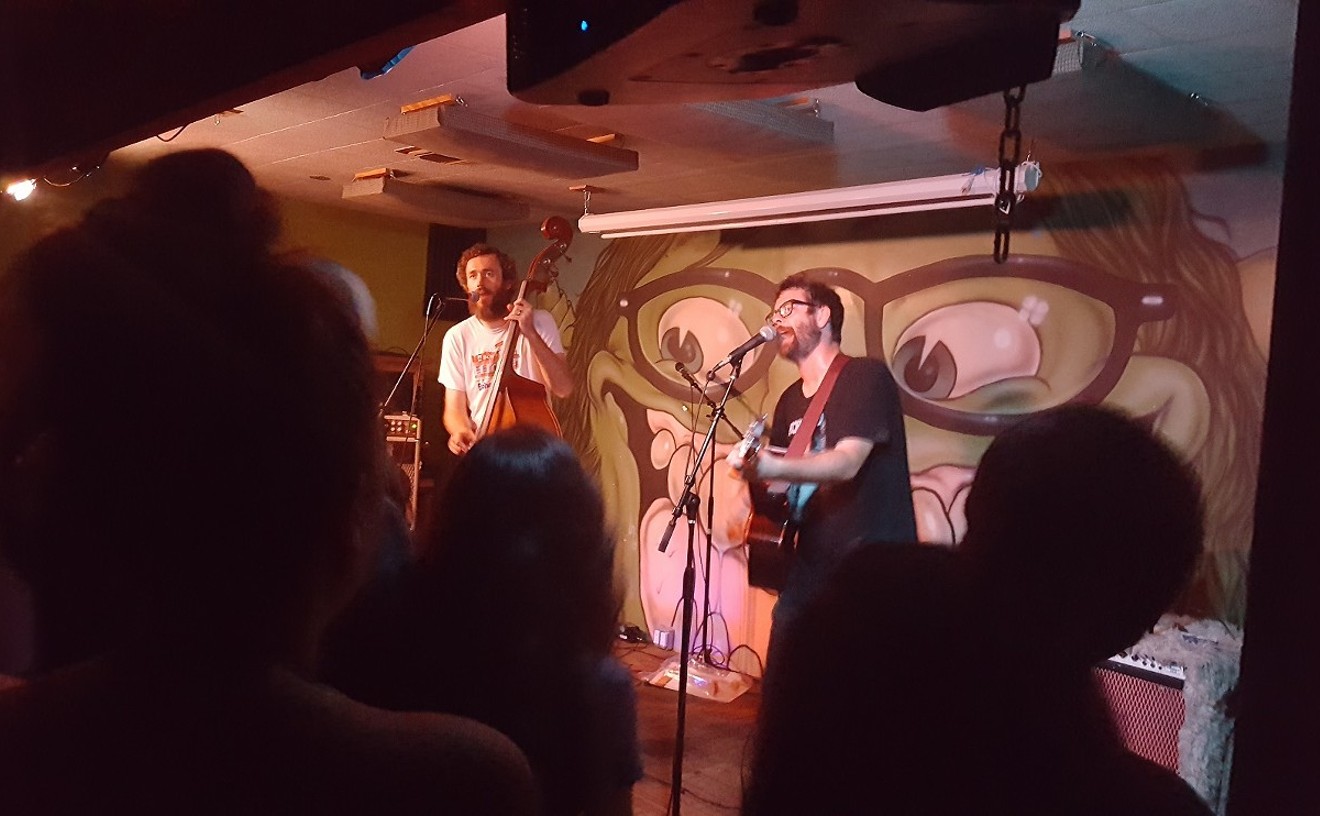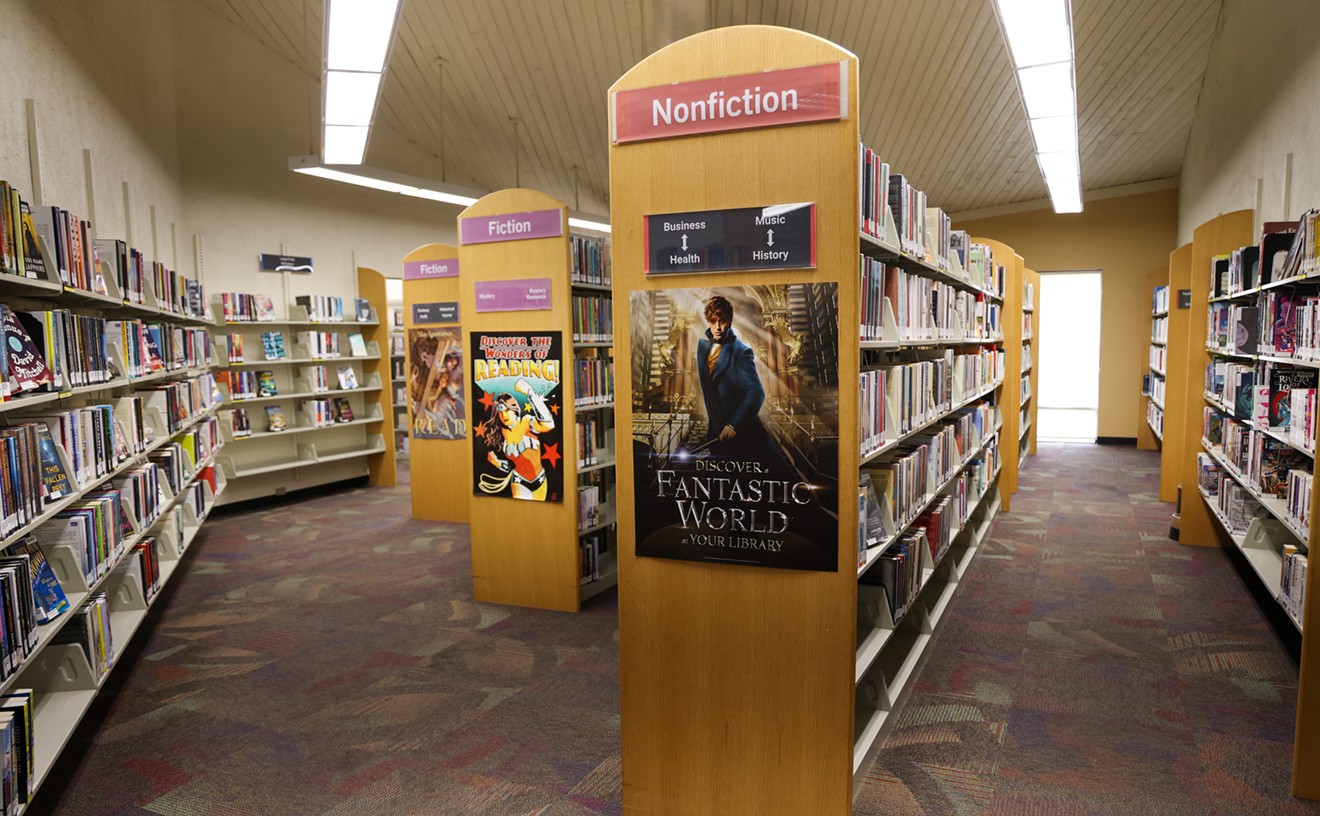Three longtime Phoenix Art Museum docents are enjoying their weekly walk along the canal in a tony Paradise Valley neighborhood. Their names might be Kathi and Martha and Jan, or perhaps Mary-Alice and Dana and Mark. They won’t say, because they’re afraid of what Amada Cruz, the 57-year-old museum director, will do to them if she finds out what they have been saying about how they hate what she’s made of their museum.
“And she always finds out,” says one of the women, who’s been a docent — one of those well-informed lecturers one sees giving tours through museums and zoos — for more than 20 years. She’d also once been a member of Contemporary Forum, one of the nine museum support organizations which, as she puts it, “Amada strangled to death with her bare hands.”
“She finds out what you said about her,” agrees one of the women, the tall one with the blond bob, “and then she makes you disappear.”
Anyone overhearing these three better-than-middle-aged people might dismiss their carping as grouchy over-dramatization, sour grapes mashed by older folks who don’t like change. Because, really, museum directors don’t kill off nearly a dozen support organizations, the very groups that raise money for the museum, that sustain memberships and promote activities and raise awareness of the museum’s programs. That’s silly. Museum directors hired to fix a growing financial deficit don’t solve that deficit by dipping into funds collected by support organizations — money earmarked for art acquisitions — in order to make payroll. That’s absurd. They don’t streamline the docent program, de-emphasizing arts education and insulting volunteers who’ve worked tirelessly for decades to promote and improve the museum they love. They don’t chase away longtime supporters and fans who’d bequeathed money and art to the museum, causing those fans and supporters to change their wills, cutting out the Phoenix Art Museum altogether. And they certainly don’t fire volunteers who have toiled for 10 or 20 or 35 years — via email, without ever meeting them — simply because those volunteers were overheard being bitchy, or because they have “bad attitudes” about all these changes. No CEO of an art museum would do such things as this.
According to these three women — and several of the more than 100 volunteers who have resigned in disgust in the past year — that is precisely what Amada Cruz has done in the four years she’s been head of Phoenix Art Museum. She has hired an inexperienced staff, they say, that knows neither museums nor art. And her approach to fixing the museum’s financial shortfall has, these former docents and dethroned organization leaders and ex-museum members claim, destroyed the spirit and annexed the accomplishments of a once-notable arts establishment.
“People used to wait in line outside Whiteman Hall to hear Cornelia Parker and Eric Fischl speak,” Nancy Millman, one of the dismissed docents, recently said. “We paid to have artists like Jennifer Steinkamp come talk to the docents, or Mary Morton, the curator of French painting at the National Gallery, speak about Gerôme.”
These days, Millman said, docents listen instead to the museum’s education director, Kaela Sáenz Oriti, tell them the best ways to give a tour.
“I have been giving museum tours longer than that little bitch has been alive,” one of the canal walkers says when Sáenz Oriti’s name comes up. She’s hushed by the woman on her right, and a brief quarrel ensues.
This might be a story about a bunch of angry women who don’t like it when things change. Its moral could be that when you treat volunteers like a bunch of yokels, they stomp off in a huff, taking millions of dollars with them. Or it may just be a repeat of that story we’ve been hearing over and over these days, as Phoenix strains to become a world-class city — the one about the out-of-towner hired to fix things, who messes everything up in the process.
Because wasn’t Amada Cruz brought in to fix the museum’s money problems? these women are asked. And hasn’t Cruz done that very thing, in nearly record time?
The women, done with their quarrel, are briefly quiet.
“Yes,” one of them finally answers. “But did she have to murder the museum in order to do it?”
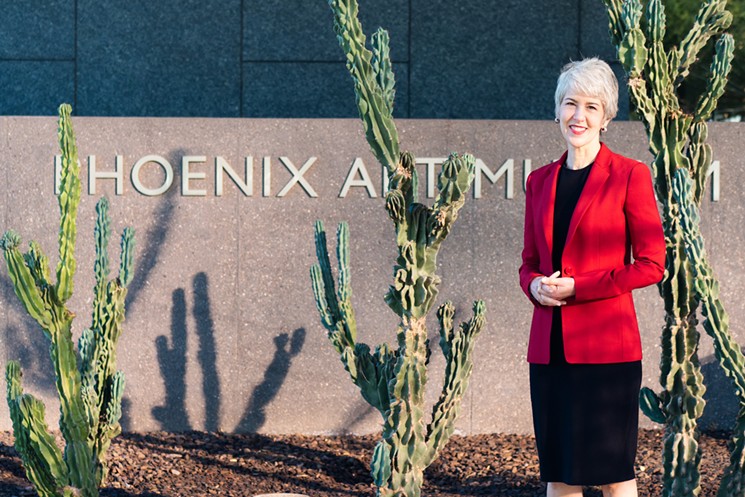
People who like to complain about Amada Cruz — and there are many of them — usually ignore the part about how she yanked the Phoenix Art Museum out of a financial mess. When she arrived, the museum routinely ran annual deficits of more than $1 million. Today, the museum is —on paper, at least — in the black. (It’s hard to say how healthy Phoenix Art Museum’s finances really are. Its audited financial statements for 2017-2018 show $40 million in assets, including $3 million in cash and cash equivalents, yet the museum has borrowed $1 million from the Arizona Community Foundation and another $1.2 million in an equity line of credit from Morgan Stanley. Why?)
During her first six months as its director, the museum increased its endowment by nearly $5 million. When she hired former Des Moines Art Center curator Gilbert Vicario as PAM’s chief curator — a position the museum hadn’t had in more than a decade — she first secured a perpetual endowment to fund that position from former Major League Baseball commissioner Bud Selig and his wife, Suzanne. Last month alone, Cruz helped the museum snag a $300,000 grant from the Ford Foundation to fund a retrospective of work by Teresita Fernández, as well as a $50,000 endowment from Thunderbirds Charities to expand the museum’s Teen Art Council.
“Amada inherited deficit spending that stopped when she got here,” says Jon Hulburd, who chairs the museum’s board of trustees. “She put together a good financial team, and convinced them to spend more wisely. In four years, she’s doubled the pace of annual contributed revenue, which is just a fancy way of saying ‘donations.’ She’s asking for money from sources we’ve never seen money from. And she’s getting it.”
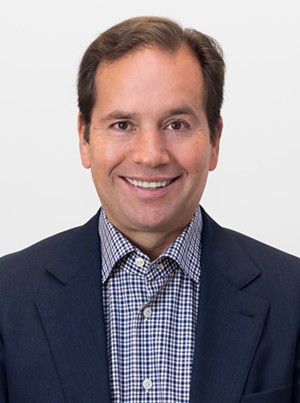
Phoenix Art Museum, founded in 1959, needs those big numbers these days. Like most arts organizations, the museum took a sock to the gut with the Great Recession of 2008. Cash donations dried up and ticket sales withered. According to a 2015 report from the Cultural Data Project, which collects and analyzes budgets and audience response to nonprofits, most museums are only now recovering from that setback.
Cruz replaced Jim Ballinger, a well-liked director who, during his 32-year stay, increased the museum’s budget and its audience, and oversaw a pair of expansions that quadrupled the facility’s gallery space. (Depending upon whom you ask, Ballinger either left of his own accord or was “shown the door” by the museum board.) Ballinger focused, many say, on the museumgoers and the volunteers who supported the institution, sidestepping turf wars between and among museum boosters and employees.
“Jim may have left the museum in the red,” says former Contemporary Forum member Mary Westheimer, the wife and manager of international artist Kevin Caron. “But he built an incredible community, something much more difficult to do than raising money. He created a macrocosm of art lovers who devoted themselves to the museum and who themselves raised money and goodwill.”
Cruz arrived in February 2015. Born in Havana, Cuba, she’d most recently been executive director of Artpace San Antonio, a nonprofit gallery, and had previously curated at Chicago’s Museum of Contemporary Art and as director of the Center for Curatorial Studies at Bard College.
Charged with reversing the museum’s growing financial deficits and determined to streamline its operations, Cruz quickly made her plans clear: She would do so by soliciting giant corporate donations and romancing big-bucks donors; she’d eschew risky blockbuster exhibitions in favor of those she knew would sell; and she’d ask her curators to build exhibits that could tour the country and increase the museum’s profile and its coffers.
In person, Cruz is charming, eager to talk about the museum’s Discount Tire Free Family Day and thrilled about the Spanish-language tours the museum now offers.
“When I first got here, I couldn’t believe we didn’t already have them,” she says with a wide smile, seated in her tidy office and surrounded by staff. “We have them now. I think that’s important in a city that’s 41 percent Latino.”
Former staff members found Cruz less charming. Within six months of her arrival, more than a dozen employees bolted, including European, American, and Western art curator Jerry Smith; development director Ronald Miller; and education director Kathryn Blake. The museum’s web administrator, Evan Roberts, also took a hike, then bitched to the Arizona Republic that he and the others had fled because they resented “Cruz’s abrasive management style.” Marketing director Carlotta Soares and public-relations manager Stephanie Lieb were among those Cruz sent packing, along with the CFO whose replacement, Kirsten Peterson Johansen, was canned less than a year later. The museum is reportedly on its third development director since Cruz arrived.
It’s not unusual for a new executive to clean house, or for staffers to flee from a new regime. But the loudest criticism of Cruz isn’t that she dumped the deadbeats from her staff or chased off a bunch of capable people who’d worked there for a long while. It’s that once she’d done that, she came gunning for a group that many consider the heart and soul of the Phoenix Art Museum. She came, according to recent legend, for the docents.
Nancy Millman still cries when she talks about the day Amada Cruz fired her from the museum docent program.
“To meet a kid who is 8 years old and never been to a museum before, to get him to see the beauty of art, it was wonderful,” she says through tears. “The fact that this was taken away from me was horribly painful. The way it was taken away was worse.”
Cruz fired Millman via email.
“She didn’t bother to meet with me,” says Millman, a retired journalist from Chicago who’d been a docent since 2001. “She didn’t care to hear what I may have been unhappy about. She didn’t care that I had volunteered for 15 years, was well-thought of, and had just had a glowing review from the docent review committee that same day.”
Millman found out she’d been canned one afternoon in November 2016, when a fellow docent called to ask why she’d quit the program. “Amada ordered that I be erased from the books,” Millman says, “and everyone was told to say I had resigned.”
Cruz won’t talk about how or why she sacked Millman. “I do not discuss personnel issues,” is all she’ll say. “And that includes volunteers. It’s really to protect the confidentiality of people like Nancy.”
Millman says she was fired for challenging authority, for being rude while trying to book a tour of the Kehinde Wiley exhibit, and for calling School Programs Manager Michelle Sparks a “condescending bitch” in a private conversation with other docents.
“Michelle gave a talk in the Phil Curtis gallery,” Millman recalls, “in which she belittled what we’d been doing for years. She told us that getting up in front of a painting and talking about the elements of art was ridiculous, that no one talks about elements of art anymore. When she was done I said, ‘Is that really what you think we do?’ She didn’t like that.”
A few days later, Millman received a call from docent president Margaret Allsup, who demanded she apologize to Sparks. “She wouldn’t tell me what I was apologizing for, so I figured it was because I’d challenged her during her talk.” Millman wrote to Sparks, saying she was sorry and explaining that she was a former investigative reporter and was accustomed to asking tough questions. She didn’t hear back.
The following week, Millman received an email from Amada Cruz, telling her she was no longer a docent.
“She ordered me not to participate anymore,” Millman says through tears. “I wasn’t even allowed to go to lunch with my docent class.”
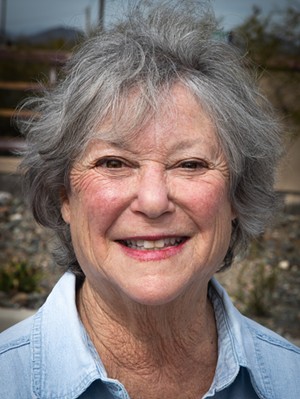
“Nancy was well-loved,” says Swan, a retired rocket scientist and former docent who joined the program in 1995. “She was the best docent, she could do everything, she worked tirelessly. She knew art history backward and forward, she gave tours in French, she worked harder than anyone. And she was fired for daring to have a bad attitude.”
Swan pauses for effect. “In an email. No one met with her to ask her to calm down or be nicer or to ask what her problem was. Amada fired her in an email.”
Swan met with Cruz in November 2016 to discuss Millman’s firing.
“I started by saying it was nice to see her again, that we had met at such-and-such a gathering,” Swan recalls. “She interrupted me to say, ‘There are 432 docents; I can’t be expected to remember you all!’”
Nothing was resolved at Swan’s meeting with Cruz, whom Swan said appeared uninterested in what she had to say about Millman or the low morale among docents.
A letter-writing campaign also had no impact, Swan reports.
“Hugh Ruddock wrote to every member of the board and to past docent presidents,” she says, referring to a wealthy longtime donor and retired master docent. “A hugely wealthy friend of mine wrote to Amada, who never responded. I have a list of rich people who tried to complain about what was happening, and were ignored.”
A meeting of docent past presidents was crashed, according to Millman, by the chair of the board of trustees, and again nothing was resolved. After that, longtime docents began meeting privately to discuss how to move forward.
And then Amada Cruz began firing more volunteers.
Some, like Sylvia Wright, whom Millman says “gave a million docent tours and worked in the gift shop,” kept their sorrow to themselves. Others, like Gail Adams, insisted on standing up for herself and her fellow docents.
If there were a competition among volunteers who are feeling bullied by Phoenix Art Museum, Adams would win. Hands down.
“I’ve received a half-dozen letters,” she boasts, then laughs. “And one of them is from an attorney!”
The first of these, from Cruz, begins with a stunningly snide reference to “aspects of your volunteer service to the Phoenix Art Museum that you have found rewarding and that previously may have been beneficial at times” — hardly a warmhearted thank you — and ends with a wry see-what-you-made-me-do? slur worthy of the worst wife-beater: “We regret your ongoing conduct has reached this point …”
Adams was a Contemporary Forum board member, enrolled in the museum’s 21st Century Society, and an early president of the Arizona Costume Institute, on whose board she served for years — until Cruz booted her in April 2016.
“I’d been overheard saying not very positive things about the changes at the museum,” Adams admits. “But I was saying them in private conversations, expressing my frustration. Apparently that is not allowed, and Amada has people listening and reporting back.”
A second email from Cruz, sent in May, was more to the point: “You and your husband are no longer members of any Support Organizations.”
Adams received yet another email from Cruz in October, telling her she was no longer permitted to attend docent lectures, a perk of her paid membership to the museum’s Circles enclave.
A certified letter from Mary Ellen Simonson, an attorney at the law firm of Lewis and Roca, arrived not long after. Simonson complains that Adams had recently spoke rudely to a museum employee and warns her to “correct your intolerable behavior.”
Adams found Simonson’s letter amusing. “The best they could come up with was to threaten to remove us as Circles members,” she says. “Too late. We hadn’t re-upped.”
“They were not running around naked at docent meetings,” says Swan of her fellow volunteers. “They were challenging authority from someone who refused to talk to them about why things were changing after they’d worked a certain way for decades.”
Elizabeth Teitel’s letter of warning came from docent president Rebecca Albrecht, after Teitel asked Sáenz Oriti, at a docent meeting, if she knew how many docents had resigned since Sáenz Oriti took over the program. That letter crossed in the mail with Teitel’s letter of resignation.
Teitel was a docent for 35 years. She left for most of the same reasons echoed by her colleagues: The current docent training has been dumbed down, de-emphasizing art history. Continuing education meetings were switched from Fridays to Mondays, when the museum and its gift shop and cafe are all closed, and who can work in a morgue? She claims Cruz shut down the Philip C. Curtis Gallery, funded as a permanent exhibit of the renowned local artist, because she doesn’t care about Arizona art. (Cruz claims otherwise, although the museum owns and historically has shown very little work by local artists.) She says Cruz did away with the docent research committee, which wrote scholarly papers designed to inform volunteers about the museum’s collection.
“Kaela and Amada decided that no one cares about art history,” Teitel grouses, “because Kaela and Amada don’t.”
Teitel and other docents complain that the museum took over booking tours, a task that docents themselves had handled for decades; and about how Sáenz Oriti disemboweled Art All Around Us, a decades-old art appreciation program aimed at senior citizens and others who can’t get to the museum.
But mostly, Teitel says, she and 100 others left because of the lousy treatment by Cruz and her staff.
“They have insulted us,” she says. “They’ve treated us like a liability instead of an asset.”
It’s true that a whopping 101 docents have exited the program in the space of a year. The total docents in fiscal year 2018 was 454; eight months later, there are 353 — a 22 percent decrease, which, according to Bigler, is unprecedented: During the three previous years, docent membership saw no drastic change.
But are things really so dire in docent land?
It certainly seems that way, though we may never know. Asked to discuss what’s good about their program since it was folded into the museum’s education program in 2017, the Phoenix Art Museum docent leadership team declined, expressing “concerns about being a part of something that they felt was aimed at presenting a negative view of Phoenix Art Museum and a docent program that they treasure dearly.” The group’s current past president, Judy Steers, had already weighed in during a phone conversation monitored by the museum’s assistant director of marketing, Margaree Bigler.
“There were more docents who did not renew their membership this year than usual,” Steers admitted. “But I’m not aware of why that might be.”
Steers claims she “hasn’t spoken to any one individual” about why so many docents are running for the door. She speaks of leaving as “an opportunity.”
“People need to go to the happy place,” she offers. “The adjustments made in museum protocol may offer an opportunity for docents to feel they have served the community.”
Bigler interrupts to suggest that many docents may have left because more docent tours are being given these days. “Maybe increased activity is not what they are looking for at the moment.”
There are so many reasons docents might be leaving in droves, according to Bigler. “Maybe there’s a health issue,” she suggests. “Or maybe they have recently moved.”
“That’s bullshit,” Cathy Swan says. “One hundred people didn’t get sick, 100 people didn’t move, and docents don’t leave because the workload increases. This wasn’t an opportunity to leave. We were marginalized, treated like servants, and no one was listening to our concerns. So we went elsewhere to find ways to contribute.”
“She was sending a message, She was saying, ‘Get out of my way. I’m in control.’ She didn’t just disrespect us. She spat upon us.” – Cathy Swan
tweet this
Among those concerns was how the docent training has been whittled away at, a point echoed by docents and defended by Cruz. The old training lasted two years and offered a crash course in art history which, many say, was the equivalent of a master’s degree.
“That first year was very intense,” Millman says. “You had mentors, consultants, you went from doing a five-minute talk to a 10-minute talk, then a half-hour. You were reviewed, and the standards were very high. The second year you wrote and researched and presented outside the museum. You learned PowerPoint and how to tour a classroom of kids.”
Today, the docent training has been simplified and trimmed by a third in its duration (though it’s still longer than most similar trainings at other big-city museums) and is geared more toward engaging museum visitors and less about educating them. The new docents are trained, Sáenz Oriti says, to ask what patrons think of the art, rather than only imparting information about it.
“It’s a great model when you’re working with kids,” Swan admits. “But adults take our tours. And they ask questions. Deflecting implies you don’t know the answer.”
So the docents fell back on their extensive knowledge of the collection, Swan says, and kept on answering questions. The people running the museum, she believes, saw that as rebellious.
Is it better for docents to know less about art history, to ask questions rather than answer them? Madelyn Mayberry, vice president of the National Docent Symposium Council, wouldn’t say. “It is not in keeping with our mission to analyze the administration of individual docent programs,” she wrote in an email, “nor to collect data with regard to administrative practices.”
There are currently 16 enrolled in the museum’s docent trainee program, according to Bigler; trainee groups are capped at between 25 and 30. Longtime master docent William Lykins isn’t worried that these trainees are learning less art history.
“I’ve heard docents aren’t using a textbook anymore, but the new docents I’ve worked with the last two years have been really good,” he says. “They’re doing good work.”
Sure, Millman says. They’re just not doing much art educating.
“I am so embarrassed to be at the center of all this,” she confesses, wiping away more tears. “I was just the first. They singled me out for challenging them. But I look like a meek little old lady, right?”
Millman wonders why Cruz thought it was a good idea to target a beloved docent for challenging the system. Swan says she’s not at all confused by Cruz’s action.
“She was sending a message,” Swan says, indignantly. “She was saying, ‘Get out of my way. I’m in control.’ She didn’t just disrespect us. She spat upon us.”
On a recent rainy Thursday, a group of mostly out-of-towners visits the Phoenix Art Museum for an afternoon tour of the contemporary art wing. Sara, the young docent leading the tour, greets each participant personally, referring to them as “guys” even though most are female. As the tour commences, Sara speaks to this group of 18 in the lilting up-speak favored by many young American women, so that most of her statements sound like questions.
“Yayoi Kusama’s You Who Are Getting Obliterated in the Dancing Swarm of Fireflies is a permanent installation?” Sara tells the group. “And we’re going to walk through it in just a bit?”
The museum visitors seem happy, and appear not to care when Sara doesn’t know the answers to some of their questions, like what mental illness Kusama suffers from or whether Cornelia Parker’s Mass, an installation piece made from bits of charred wood, is chemically treated. It isn’t her fault that most of her description of the Kehinde Wiley painting is drowned out by a hydraulic lift on the first floor, and no one notices that she asks more questions of the crowd (“What does James Turrell’s Mohl Ip make you feel?”) than she imparts information.
Afterward, a retired couple from Indiana named Jen and David waits outside for their Uber. They enjoyed seeing the museum, they tell a man who’d been on the tour with them, especially the armory show and the cloud of black paper moths in the lobby.
But aren’t they concerned, the man asks, that the docent who’d toured them through the modern and contemporary collections asked more questions than she answered?
“Oh, not at all,” Jen chuckles. “We’ve traveled the world, see, and we’ve been to many museums. This is a second-tier museum, so our expectations were pretty low.”
David jumps in. “And anyway, it was nice to see a young person volunteering at a museum. It makes you forget that after people our age are gone, no one is gonna be here to support these places.”
“I thought 11 support groups was a lot of support groups,” she says. “Many of them had been around for decades, which is a wonderful accomplishment, but everything has its life cycle.” – Amada Cruz
tweet this
If it’s a lousy idea to piss off a bunch of people who work for free, it’s an even worse idea to go after the volunteer organizations who’ve supported that museum for decades — with artistic and financial goodwill, and community bridge-building, and by purchasing art for that museum. Where the Phoenix Art Museum had, for decades, as many as 11 different art support organizations, it now has two. Most were folded after Cruz arranged for the organizations, long autonomous, to be overseen by the museum staff.
The Women’s Art League was among the first casualties, followed by Friends of European Art; In Focus, a photographic art group; Friends of Latin American Art; the Men’s Art Council; Friends of Asian Art; and Contemporary Forum, perhaps the best-known of the groups. French Thompson was its past president.
“They’re all gone now, those and others,” Thompson says. “Amada and her crew went to each of the groups and said, ‘We’re bringing you in-house.’ They wanted control of our money and were going to use it how they saw fit.’”
In a letter dated December 2016, Cruz explained to volunteers that she’d consulted with attorneys who recommended the museum corral its support organizations, to bring them in-house for safekeeping. All that autonomy was a bad risk, Cruz says. She seemed surprised to learn, upon arriving at the museum, that there so very many such groups.
“I thought 11 support groups was a lot of support groups,” she says. “Many of them had been around for decades, which is a wonderful accomplishment, but everything has its life cycle.”
Cruz appears to have been worried that the creaky old support organizations were falling apart. “I could see that they were having trouble,” she says. “They were struggling with membership, getting people to join, raising money, all of that.”
The museum wanted, Cruz said in her letter, to “bring necessary structure to the support groups.”
“We already had structure,” Swan groans. “They kept saying the phrase ‘best practices.’ If I heard it once more I was going to hurl. It was corporate speak for ‘We want your money to pay our bills.’”
Told that the museum wanted control of the support organization money to make its payroll, Cruz chuckles. “I hadn’t heard that one before,” she contends, although in that letter to support organizations, Cruz writes, “Beginning in FY18 (July 1, 2017 – June 30, 2018), a percentage of all funds raised by a support group in excess of its approved, budgeted expenses will be paid to the Museum to support administrative and programmatic expenses…”
Swan, a founding member of Friends of European Art, laughs when she hears that Cruz thought the support organizations were faltering. “We were not having trouble raising money,” she insists. “The museum needed our money to pay its bills and get out of the red and into the black. They got our money, but they lost our support.”
That money always belonged to the museum, Hulburd says, because the groups were linked to and financially supportive of the Phoenix Art Museum. “Donors gave that money to support the museum,” he clarifies, “and not necessarily to support the support group. After the groups bought us a painting or whatever, the remaining funds were meant to be used by the museum.”
It’s all moot, Mary Westheimer says. Nine of the 11 support organizations are gone. The goodwill they created is gone. The art they might have bought won’t be found on any walls. “But I guess the museum got what they wanted,” she says. “A bunch of money, right now.”
But what about later?
“I had two and a half minutes to show how I’d documented a loss of $60 million in estate-planning gifts to the museum over just four months ... from people who were angry or hurt and were withdrawing their bequests.” – Cathy Swan
tweet this
When what she calls “the explosions” first began — not long after Nancy Millman was fired and before the last of the support groups folded — Cathy Swan began to think about the long-term fallout of those explosions. In February 2017, Swan and five other volunteers met with the museum’s board of trustees.
“We were given 15 minutes, total,” Swan remembers. “I had two and a half minutes to show how I’d documented a loss of $60 million in estate-planning gifts to the museum over just four months, between November 2016 and February 2017, from people who were angry or hurt and were withdrawing their bequests.”
After she spoke, a board member told Swan it wasn’t their job to worry about other people’s estate planning. “They said they were in the black, and that was what mattered,” Swan recalls.
The museum doesn’t care, Swan believes, about the list of people — some of them quite wealthy — who are disinheriting Phoenix Art Museum.
Gail Adams is among them; she has cut PAM out of her will. Nancy Millman had arranged for her antique jewelry collection and several 19th-century French lithographs to be left to the museum; she’s since found another home for them. French Thompson had a letter from a couple who’d previously bequeathed millions of dollars in property to Phoenix Art Museum, but have recently made other arrangements.
That $60 million figure Cathy Swan came up with two years ago has since grown. Hulburd says he’s heard that former museum members are changing their wills, and it makes him sad. “But because we don’t currently track planned giving, we can’t really count on that as income, or regret it as lost income.”
Likewise, Cruz seems unfazed by the notion that unhappy museum members are taking their marbles with them when they leave. “You never know what someone’s going to leave you until they’ve gone on to that better place,” she says. And then she smiles.
"She’s run everybody off, she’s killed off all the support groups, she took all the fun and the smarts out of the museum." – Docent
tweet this
The trio of docents has nearly completed their weekly walk along the canal. One of them, the one whose name might be Martha, has stopped to talk to a homeless man named Bud. “She’s always trying to give him a sandwich,” the woman who might be Kathi confides to a friend who has joined them. She stops to shake a rock out of her shoe and resumes complaining about the Phoenix Art Museum docent program.
But why, if the program is so terrible, do these three stay on? their friend asks. Jan says she likes the social aspect of the docent group. “Some of my oldest friends are docents,” she offers. “I’ve been doing it so long …” she begins, her voice trailing off.
Martha gives up on Bud, who doesn’t want lunch, and rejoins the others, who are walking in place on the canal’s towpath. “I’m leaving docents when my membership is up in June,” she says, and Kathi groans.
“Maybe Amada will leave before then,” Kathi says.
“I hope so,” Jan replies. “I’ve been praying she will. I’ve been lighting candles.”
It won’t matter, Martha insists. “Even if she does go, it’s too late. She’s run everybody off, she’s killed off all the support groups, she took all the fun and the smarts out of the museum. She’s a cash register, and a cash register doesn’t care about art. A cash register has no soul. As far as some of us are concerned, there is no Phoenix Art Museum anymore.”

